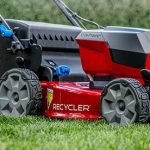Thatch is a layer of organic material that develops between soil and grass/plants. It can be comprised of either living or dead matter. It is a particularly tricky subject for lawn care because it has positive and negative effects. On the one hand, a small layer of thatch can have some positive effects. In areas that experience a lot of traffic, thatch can cushion your turf. It also shields the surface from the sun, thereby lowering the soil temperature and protecting against crabgrass. At the same time, it is a breeding ground for insects and disease, and it results in shallow roots. For these reasons, even if you are enjoying the benefits of thatch, it is a good idea to control it.
When does thatch become a problem and what causes it?
That occurs when your lawn grows too fast. As such, it most commonly results from overwatering and overfertilizing. If you live in an area with lots of shade and rainfall and still water your lawn religiously, don’t be surprised if a thick layer of thatch sprouts up. A good rule of thumb is that whenever it grows beyond ½ inch, it should be dealt with.
How can thatch be controlled?
There are a couple of effective methods for dealing with thatch, and an important lawn care tip to remember is that you want to loosen up the soil and improve drainage. One of the most popular is to use a core aerifying machine. These draw the soil up toward the surface, allowing it to reacquaint itself with the sun and solving the existing drainage issues. Aerifying should be done in the early Spring or the fall, not during the height of the growing season. Another method is known as topdressing. With this approach, you add a thin coating of soil over the thatch, allowing the lawn to once again obtain the necessary nutrients.
Ultimately, thatch requires a delicate balance because you want to reap the benefits of thatch while preventing it from getting out of hand. By following these guidelines, you can be sure that thatch never becomes a detriment to your lawn.







